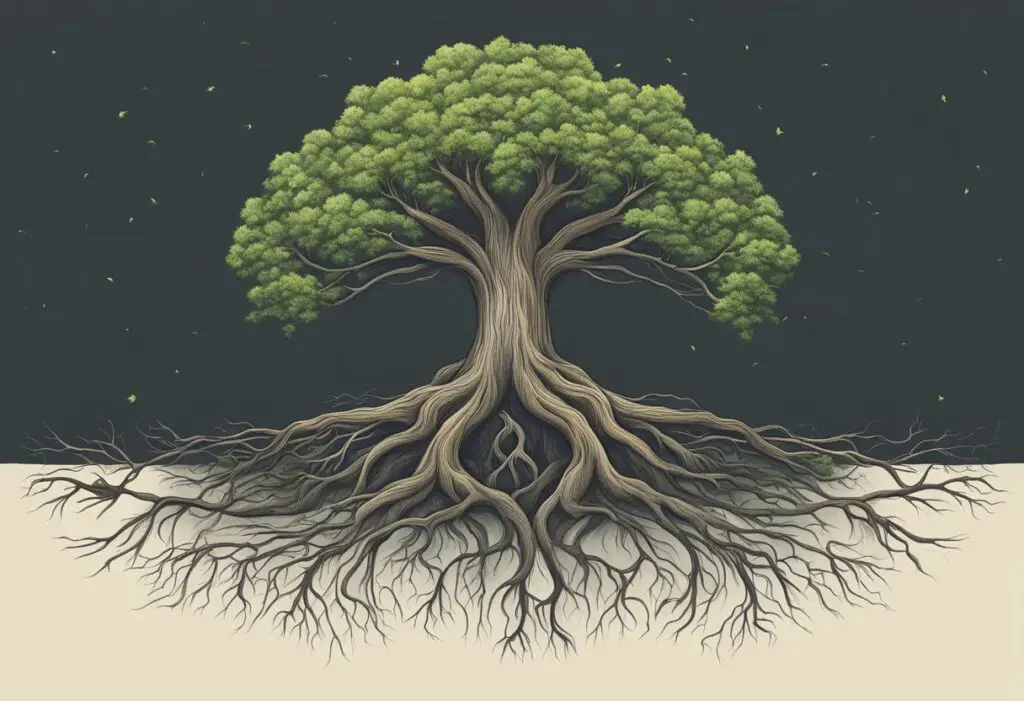So, you want to know about the importance of a growth mindset, eh?
Well, let me tell you, it’s a pretty big deal. A growth mindset is the belief that you can improve your abilities and intelligence through hard work, dedication, and perseverance.
This mindset is in contrast to a fixed mindset, which is the belief that your abilities and intelligence are fixed and cannot be improved.

The concept of a growth mindset was developed by Carol Dweck, a Stanford psychologist, who found that people with a growth mindset were more likely to succeed in school, work, and life. With a growth mindset, you are more open to learning, more willing to take risks, and more resilient in the face of failure. You see challenges as opportunities for growth rather than as threats to your self-esteem. In short, a growth mindset can help you achieve your goals and reach your full potential.
So, if you want to be successful in life, it’s important to cultivate a growth mindset. But how do you do that? Well, that’s a topic for another article. Stay tuned!
The Great Debate: Fixed Vs Growth Mindset
The Fixed Mindset Fallacy
You might have heard people say things like “I’m just not good at math” or “I’ll never be able to learn a new language”. These are examples of a fixed mindset, where people believe that their abilities and talents are fixed and unchangeable. This type of thinking can be limiting and prevent you from reaching your full potential.
The fixed mindset fallacy is the belief that your intelligence and abilities are predetermined and cannot be improved upon. This type of thinking can lead to a lack of effort and a fear of failure. When you believe that your abilities are fixed, you are less likely to take risks and try new things.
The Glory of Growth Mindset
On the other hand, a growth mindset is the belief that your abilities and talents can be developed through hard work and dedication. When you have a growth mindset, you see challenges as opportunities to learn and grow. You are more likely to take risks and try new things because you believe that you can improve.
-

Bold Male Pride – Baseball Trucker Cap Celebrating Masculinity
£18.00 Select options This product has multiple variants. The options may be chosen on the product page -

Dad Bod Appreciation Gift Mug
£14.00 Add to cart -

Dad Bod, Bad Jokes Structured Baseball Cap
£22.00 Select options This product has multiple variants. The options may be chosen on the product page
The glory of a growth mindset is that it can help you achieve your goals and reach your full potential. When you believe that your abilities are not fixed, you are more likely to put in the effort to improve. You are also more likely to bounce back from failure and setbacks because you see them as opportunities to learn and grow.
Beliefs play a crucial role in shaping our mindset. When you have a growth mindset, you believe that your abilities can be developed through hard work and dedication. This belief can help you overcome limiting beliefs and achieve your goals. On the other hand, a fixed mindset can keep you stuck in limiting beliefs and prevent you from reaching your full potential.
In conclusion, the great debate between fixed and growth mindset is an ongoing one. While some people believe that abilities and talents are fixed, others believe that they can be developed through hard work and dedication. It’s up to you to decide which mindset you want to adopt. Remember, a growth mindset can help you achieve your goals and reach your full potential.
The Art of Fumbling: Embracing Mistakes and Setbacks
Mistakes and setbacks are inevitable. They are a natural part of the learning process and a necessary step towards growth. Instead of fearing them, embrace them! Here are some reasons why:
The Beauty of Blunders
Think about it: If you never made a mistake, you would never learn anything new. Mistakes are an opportunity to learn, grow, and improve. They help you identify areas that need work and give you a chance to try again. So, the next time you make a mistake, don’t beat yourself up over it. Instead, celebrate the fact that you are one step closer to success!
The Silver Lining in Setbacks
Setbacks can be frustrating, but they are not the end of the world. They are a chance to practice resilience and adaptability. When you encounter a setback, take a step back and assess the situation. What can you learn from it? How can you use this experience to improve in the future? Remember, setbacks are temporary. They do not define you or your abilities. With effort and persistence, you can overcome them and come out stronger on the other side.
In conclusion, the next time you fumble, don’t give up. Embrace your mistakes and setbacks as opportunities for growth and learning. With a growth mindset, you can turn even the biggest blunders into valuable lessons. Keep pushing forward, and you will see the results of your efforts in no time!
The Neural Nitty-Gritty of Growth Mindset
Are you curious about what’s going on inside your noggin when you embrace a growth mindset? Let’s take a peek at the neural nitty-gritty of growth mindset.
Your Brain on Growth Mindset
When you adopt a growth mindset, your brain is primed and ready to learn. Instead of throwing in the towel when faced with a challenge, your brain sees it as an opportunity to grow. This is because a growth mindset activates the brain’s reward centers, releasing dopamine and giving you a sense of accomplishment.
On the other hand, a fixed mindset can put the brakes on learning. When you believe that your abilities are set in stone, you’re less likely to put in the effort to improve. This can lead to a vicious cycle of frustration and stagnation.
Neuroplasticity: Your Brain’s Secret Superpower
Did you know that your brain has the power to change and adapt throughout your life? This is called neuroplasticity, and it’s your brain’s secret superpower.
When you learn something new, your brain creates new neural connections. The more you practice, the stronger these connections become. This is why repetition is key when it comes to learning.
But here’s the kicker: neuroplasticity isn’t just for kids. Your brain has the capacity to change and grow no matter your age. So don’t let anyone tell you that you’re too old to learn something new.
So, what’s the takeaway here? Embracing a growth mindset can unlock your brain’s full potential. By believing that you can improve, you’re setting yourself up for success. And with the power of neuroplasticity, you can keep growing and learning for years to come.
Cracking the Code: Growth Vs. Fixed Mindset
Imagine you have two mini versions of the brilliant Carol Dweck sitting on your shoulders. One represents the growth mindset, while the other represents the fixed mindset. Got the image in your noggin? Great! Now let’s see how they’d react to your children’s challenges.
When your kiddo faces a tough puzzle, growth mindset, Carol would exclaim, “You can learn to solve this! Keep trying, and your brain will thank you!” On the other hand, fixed mindset, Carol might sigh, “Well, it’s just not your strong suit, so why bother trying?” Now, which Carol would you rather have on your side?
Let’s say your little one is learning to ride a bike. As they wobble and topple, growth mindset Carol cheers, “Falling is part of the process! You’re building those biking muscles!” Meanwhile, with a fixed mindset, Carol might roll her eyes and say, “Face it, you’re just not the athletic type.” Clearly, with a growth mindset, Carol is way more fun at the playground.
Here’s the real magic, though: neuroplasticity is a fancy-shmancy term that proves our brains can indeed change and learn throughout our lives. So even if you’ve accidentally nurtured a bit of fixed mindset-itis, your little ones can still learn to adopt a growth mindset!
It isn’t Hogwarts, but Stanford University is where Carol Dweck, the queen of growth mindset herself, hails from. Her fantastic book, Mindset: The New Psychology of Success, makes it clear that with effort, perseverance, and a dash of humor, anyone can learn to adopt a growth mindset.
So go on, sprinkle some growth mindset magic through your daily chats with your kids, and watch them soar like Gryffindor Quidditch players!
Applying Growth Mindset in Real Life
So, you’ve read about the importance of a growth mindset, and you’re ready to apply it in real life. Great! Here are some ways you can use a growth mindset in different areas of your life:
In the Classroom
Are you a student looking to improve your grades? Adopting a growth mindset can help you achieve your goals. Instead of thinking that you’re just not good at a subject, focus on the idea that you can improve with effort and practice. Try these tips to apply a growth mindset in the classroom:
- Embrace challenges: Don’t shy away from difficult assignments or classes. Instead, view them as opportunities to learn and grow.
- Learn from mistakes: When you make a mistake, don’t give up. Instead, use it as a chance to learn and improve.
- Ask for help: Don’t be afraid to ask for help from teachers or classmates. Seeking assistance is a sign of strength, not weakness.
In the Workplace
Are you looking to advance your career? A growth mindset can help you achieve your professional goals. Here are some tips for applying a growth mindset in the workplace:
- Embrace challenges: Don’t shy away from difficult projects or tasks. Instead, view them as opportunities to learn and grow.
- Learn from mistakes: When you make a mistake, don’t beat yourself up. Instead, use it as a chance to learn and improve.
- Seek feedback: Don’t be afraid to ask for feedback from your colleagues or boss. Constructive criticism can help you improve.
In Personal Relationships
Are you looking to improve your relationships with friends, family, or romantic partners? A growth mindset can help you become a better listener, communicator, and problem solver. Here are some tips for applying a growth mindset in your personal relationships:
- Embrace challenges: Don’t shy away from difficult conversations or conflicts. Instead, view them as opportunities to learn and grow.
- Learn from mistakes: When you make a mistake in a relationship, don’t blame others or ignore the issue. Instead, use it as a chance to learn and improve.
- Practice empathy: Try to see things from the other person’s perspective. This can help you communicate more effectively and resolve conflicts more easily.
The Journey to a Growth Mindset: Tips and Tricks
Congratulations! You’ve decided to embark on the journey to developing a growth mindset. It won’t be easy, but it will be worth it. Here are some tips and tricks to help you along the way:
Embrace Hard Work
You might have heard the saying, “hard work beats talent when talent doesn’t work hard.” It’s true! A growth mindset means recognizing that success is not just about natural ability but also about putting in the effort. So, embrace hard work and don’t be afraid to put in the time and effort to achieve your goals.
Welcome Feedback
Feedback can be tough to hear, but it’s essential for growth. A growth mindset means recognizing that feedback is a gift and using it to improve. So, welcome feedback with open arms and use it to become better.
Stay Motivated
Motivation is key to achieving your goals. A growth mindset means recognizing that motivation comes from within and finding ways to keep yourself motivated. So, find your purpose, set goals, and stay determined.
Step Out of Your Comfort Zone
A growth mindset means recognizing that growth happens outside of your comfort zone. So, challenge yourself, take risks, and try new things. You might surprise yourself with what you’re capable of.
Keep a Positive Attitude
A growth mindset means recognizing that your attitude can impact your success. So, keep a positive attitude, and focus on the possibilities, not the limitations.
Find Your Purpose
A growth mindset means recognizing that your purpose can drive you to achieve your goals. So, find your purpose, and let it guide you on your journey to success.
Remember, developing a growth mindset is a journey, not a destination. It takes time, effort, and determination, but the rewards are worth it. So, embrace the journey, and enjoy the ride!
The Science Behind Nurture and Nature
Ever wondered about the science behind your kid’s growth mindset and fixed mindset? Well, buckle up because you’re about to take a roller coaster ride through the fascinating world of neurons and neuroplasticity. And don’t worry, we promise to keep it humorous!
You see, your child’s brain is an amazing and complex organ, always learning and adapting. That’s where nurture comes into play. By instilling a growth mindset in your child, you’re helping those little neurons in their brain form connections that strengthen their learning process. Call it “brain training,” if you will.
But how does this brain training work? It all comes down to neuroplasticity, my friend. This fancy term refers to your brain’s ability to change and adapt throughout life. Essentially, your brain is like a super flexible, stretchy rubber band, capable of incredible feats of learning and growth. It’s the superhero of organs, really.
Now, let’s talk about habits and how they fit into this whole “nurture vs. nature” thing. Habits, you see, are the building blocks of the learning process. By encouraging your child to form positive habits that promote a growth mindset, you’re essentially sculpting their brain into an unstoppable learning machine.
- Neurons: Tiny brain cells that transmit information – think of them as your child’s brain’s BFFs!
- Neuroplasticity: A big word for the brain’s exciting ability to change and adapt – go, brain, go!
- Learning process: The beautiful dance between neurons and neuroplasticity – cha-cha-cha!
- Nurture: Your role in shaping your child’s mindset and habits – you’re like a brain-sculpting artist!
- Habit: The brain’s way of automating tasks – making life easier for you and your child!
Parental Guidance Recommended: Talking Mindsets at Home
At home, it’s crucial to communicate with your kiddos in a way that encourages a growth mindset rather than a fixed mindset. Trust us, your little ones will thank you later. Let’s dive into some tips and tricks to foster resilience and recognize progress in your daily conversations.
Phrases that Foster Resilience
Humor us for a moment and imagine this scenario: Your child comes home with a less-than-stellar report card. Now, before you start panicking, remember – it’s an excellent opportunity to implement a growth mindset! Here are some phrases that’ll help them bounce back like a champ:
-
“I see you’ve worked hard on this subject; let’s figure out how to tackle areas where you need improvement.” Emphasizing effort rather than grades or talent will encourage resilience in the face of setbacks.
-
“What strategies can we explore to help you better understand the material?” This question focuses on finding solutions rather than dwelling on the problem.
-
“Remember, setbacks are part of the learning process.” Teaching your child to embrace challenges instead of fearing them is the secret sauce for developing grit.
Feel free to mix and match these phrases as you see fit. Just remember to provide constructive criticism and positive feedback while keeping a light-hearted tone.
Recognizing and Rewarding Progress
Resilience is crucial, but it’s equally important to recognize and reward progress when it occurs. The way you praise your child can significantly impact their mindset. Here are a few examples:
-
“Wow, you’ve improved significantly since the last test. Your hard work and dedication are paying off!” This type of praise emphasizes improvement and dedication rather than innate talent.
-
“I’m proud of how you’ve grown in your communication skills. Keep up the good work!” Acknowledging specific achievements encourages your child to continue developing those areas.
-
“You’re learning from your mistakes, and that’s a valuable skill in life.” Reinforcing the idea that mistakes can be learning opportunities bolsters your child’s resilience.
Remember, fostering a growth mindset at home is a long-term commitment, not a one-off conversation. So, keep these tips in your back pocket and add a dash of humor. Your young ones will be embracing challenges and building resilience in no time!
The Classroom Chronicles: Fostering Growth Mindset
The Math Meltdown
Picture this: your kid’s sitting at the kitchen table, struggling with their long division homework. They throw their pencil down in frustration and say, “I just can’t do it! I’m bad at math!”
In that moment, try to change their mindset. Remind them that mistakes are a natural part of learning and they can improve with effort and practice. Instead of using fixed mindset language (like “I can’t” or “I’m bad at”), try encouraging a growth mindset by saying things like “You haven’t mastered it yet, but keep trying” or “Remember that time you struggled with soccer but kept practicing and got better?”
The Science Showdown
Another day, another science project went awry. Your kid’s volcano experiment results in a, well, messy explosion. Before they start crying about their ruined project, help them see the opportunity for growth in this setback. Discuss how failure can lead to progress in understanding the world and building resilience.
Emphasize the importance of perseverance and collaboration. Encourage your child to work with classmates to find new solutions or approaches to the problem. Recognize their hard work, dedication, and learning process rather than fixating on their perceived intelligence or talents.
By fostering a growth mindset in your children, you’re preparing them for challenges both inside and outside the classroom. From tackling difficult problems to developing a positive attitude toward setbacks, this mindset can help them develop the vocabulary and skills they need for success in college and beyond. So go ahead, embrace those math meltdowns and science showdowns, and watch your kids grow!
Sports Superstar: Growth Mindset Statements For Sports
Growth Mindset v Fixed Mindset Statements For Sports
Let’s kick things off with a fun, quick dive into sports superstar statements that demonstrate a growth mindset versus a fixed mindset. Remember, talking to your kids with growth mindset statements helps them embrace learning, resilience, and the belief that hard work can improve their abilities.
Fixed mindset statement: “You just don’t have the talent for soccer, kid.”
Growth mindset statement: “You may not be a pro, but with practice and dedication, you can certainly improve your soccer skills.”
Kids can easily get discouraged when they’re told they simply lack the talent for a sport. By using humor and a growth mindset approach, you can help them find a middle ground while still motivating them to chase their goals.
Fixed mindset statement: “You’ll never be as fast as Usain Bolt. Why bother trying?”
Growth mindset statement: “Even Usain Bolt had to start somewhere—keep training, and who knows how fast you could become!”
In this situation, you’re taking a pretty big leap by comparing your child to one of the most famous athletes of all time, but remember, humor can be a powerful tool. Use it wisely to inspire your kids and keep them laughing as they work towards their athletic goals.
Fixed mindset statement: “You’ve always had a horrible aim. Basketball just isn’t your thing.”
Growth mindset statement: “Aiming takes time and practice. Keep practicing, and you’ll shoot more hoops in no time.”
Teasing your kids in a lighthearted way about their basketball skills can help them chuckle at their own blunders while still wanting to improve. It’s important to make sure that the joke is on point and not offensive. After all, laughter is the best medicine, even in sports.
To sum up, when talking to your kids about sports, focus on blending humor with positivity and a growth mindset. Your witty remarks will not only encourage their efforts and motivation but also help them learn to laugh at their own shortcomings and enjoy the journey towards becoming their own version of a sports superstar.







